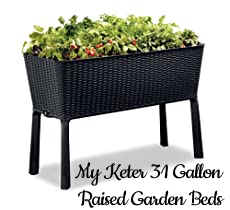|
|
|
I've been growing them for a decade for eating fresh, baking into desserts, canned as jams and preserves, bottled as syrups and saving frozen slices for winter. Because of my needs, my preferences are big, fat, juicy berries with a high sugar content, and plants that are both June-bearing and everbearing in Zone 6. I grow several different varieties, and i choose the types that are disease resistant. I've grown berries from bare roots and i've grown them as small plants. Both do very well. I'd prefer the plants because they've got a lot of growth, but the individual plants are pretty pricey to fill a large bed. Roots average approximately $1.00 each and usually sold in bundles of 25-50. These have green growth from the crowns, and begin to grow quickly if planted correctly and kept watered. Strawberries are a favorite food of rabbits, birds and deer. I haven't had bugs, but i do battle with fungus diseases when it's wet and humid for long periods of time.
To deter the small animals, i grow them
in raised garden beds and put a bird/small animal netting over the bed
just as soon as I see the flowers. This is stretchy, and i cover loosely
to allow the plants to get tall. The plants will push out leaves through
the netting if they need more space. I don't have a problem with birds
feasting on my fruiting plants because they have a habitat designd for
them and are well fed on seed and bugs. In fact, i don't have a bug
problem at all, because the birds just love fresh insects, they love the
honeysuckly berries, and they leave my food alone. I heard tell that
honeysuckle berries are poisonous to birds, but they do just fine in
their habitat. Birds are insect-eating machines. If you supply food,
water and shelter, they'll feel safe and will begin to breed their
families in your yard, thereby increasing the bug-elimination. I haven't
been bitten by a mosquito at night in my gardens for a decade, even with
a bog garden and water features.
Types of Strawberries June-bearing varieties bear fruit all at once, from late May-June, and usually over a period of three or four weeks. Sensitive to day length, these varieties produce fruits and then produce runners during the long days of summer. These runners are called "daughters", and they will take root and become their own plant. I clip these runners under 2 circumstances - when i want larger berries because the energy is not weakened by the long runner (fewer, but still plenty of berries) - and when little plants along the runners have visible roots and can be cut off and planted as a single ew plant. Strawberry plants live 3-5 years before they should be replaced with new ones, and these plants from the runner will begin the cycle again, replacing the old worn-out plants. Everbearing varieties produce a big crop in spring, produce lightly now and then in the summer, and then bear another crop in late summer/fall. I have yet to see a fall crop from my everbearing plants. Day-Neutral varieties produce fruit continuously through the season, until the first frost. Insensitive to day-length, these varieties produce buds, fruits, and runners continuously if temperature remains between 35° and 85°F. Strawberries grow beautifully in big hanging pots, patio pots and raised beds. I have several raised beds in different areas, so that if there's a fungus, bug or critter problems, they won't share it with each other, and I won't lose all the plants. I also like to spread them out to draw the pollinators into different areas of my garden to work their magic on my ornamentals and vegetables. I grow a few different varieties that produce big, beautiful, sweet strawberries. I grow berries that are cold hardy in zone 6b. My favorites,
and I grow all of them:
Seascape (everbearing), Allstar, Ft. Laramie, Ozark Beauty. Update: This
season's Seascape everbearing roots were planted in March.
How To Grow and Care For Strawberries... My Seascape berries just produced again in July - here are the photos.
There's By The Book (Conventional and correct Wisdom) and then there's My Way. Plan to plant as soon as the ground can be worked in the spring. I have planted just as soon as i can move soil and dig with my trowel, which is usually in mid-march. I have also done successive plantings so that i have young and mature plants producing in succession. I also plant in early fall for a new batch in spring. They don't seem to care when you plant them, as long as they're planted right and get enough, but not too much, water. Establish some new plants each year for high-quality berries each season. Runners will will root all summer and grow into new strawberry plants. My runners are producing strong daughter plants wherever they can grab onto, including at the bottom of my fence.If bugs are a potential problem, I use Diamataceous Earth (DE). It's a natural pesticide made from powdered fossils. This has sharp microscopic shards that injure the bug while it waltzes through your garden, and it has silica in it, a dessicant that is known to suck up dampness and fluid wherever you use it. Silica is used to dry and preserve flowers. This is a natural way to kill garden pests and it's non-toxic. The bugs walk around in it when it's sprinkled on or around your plants, they get it stuck to themselves, and the teensy cuts they get on their bodies from the fossil dust means the bugs dehydrate and byebye bugs. For fungus problems due to long periods of hot or cool, rainy and damp weather, I spray on natural Neem Oil as a fungicide on all plants when they're dry, and especially on fruit trees, plants and shrubs. It can be used til day of harvest. I haven't had to spray more than once, so far. Many varieties have been bred to be resistant to fungus and disease. Heirlooms do not have this resistance. Where and in what?Strawberry plants require 6-10 hours of direct sunlight per day. They can take some shade, too. The plants I grow in partial shade look better and healthier during a heatwave. Perky and a very pretty shade of emerald green.You can plant and grow strawberries in any type of hanging container or pot. The planting site in the garden must be well-draining. If your garden soil is not very good, plant in raised garden beds. They come in cedar and heavy duty resins - i like the plastics. Cedar elevated beds last me about 3 or 4 years before beginning to sag or pop their joints. Just like people. Even when you weather-proof the cedar, (or any other weather-proof wood) it will break down over time. The big plastic beds last forever. Mine have a water level gauge and a drain plug to release excess water. Worth every penny, and raised beds look organized, add visual height, and look beautiful in the garden and on the patio. If you opt for building your own wooden raised beds, do NOT use treated wood for fruits and veggies. Those chemicals will leach out and they will be in your food. I would favor cedars, fir and bamboo. Bamboo is a more sustainable, although it's a more expensive choice. I have 6 resin elevated raised garden beds, so far. They contain strawberries, my kitchen garden, patio tomatoes and trailing cherry tomatoes, and kitchen herbs. They're 31.7 gallons, about 45 inches long and 19 inches deep - deep enough to grow bulbs and root veggies. I squeeze about 18 strawberry plants into it. Height with legs is 30 inches high, making it so easy for everyone to grow a garden without the bending. There's a drain plug on the side to release excess water if you've gotten days of heavy rains. I prefer to leave my plug out all the time to avoid too much moisture. If we're in for a dry spell, i leave the plug in. These are an urban and small space gardener's delight. You can leave the legs off and place these on the ground. You just easily pop the legs on or off. So, you can have some standing and some beneath those on ground level, and create a tiered garden. Just be sure to leave space behind or on the sides of the standing bed, so you can work in it. I have shallow pots with succulents and shade-loving ferns and flowers sitting underneath. Lots of plants taking up a lot less space than planting in-ground. They're made of resin, so they stand up well to weather. I'm putting one indoors for a winter garden. You can find these online at Home Depot, Walmart and Amazon. I wait for a sale. Each planter holds 4 cu. ft. of soil (2 of those big 2 cu. ft. bags).
Cross-pollination. I am designing a large strawberry bed that includes potted butterfly weed (i don't want them taking over the bed) to attract pollinators. Butterfly weed in orange, red and yellow look stunning, as do cardinal flowers, combined with the strawberries. Strawberries are tolerant of different soil types, as long as it drains well. Raised beds are excellent for strawberry plants. My raised beds have a drain plug for releasing excess water. You can grow strawberries in half-barrels, pretty pots, and large containers filled with a good potting soil.
How to Plant... Provide space for sprawling. Set plants out 18 inches apart to leave room for runners and leave 4 feet between rows. That's what the books say. But. I successfully grow strawberries and plenty of runners, even when i allow less than a foot apart for the plants. I would rarely leave 4 ft. between rows of anything. My gardening style is more along the lines of square foot gardening, with plants at less than a foot apart, and i don't do rows. I stagger the plants. Compact planting has not done any harm. But you do want to keep an eye on potential fungus or disease when they're that close.You can always move and transplant the plants and runners if you need to give them more space. Some folks say that if you plant too close, your berries and harvest will be small. That has not been the case in my gardens. I have many plants planted the way they would grow in nature. Without measurements and fairly cramped, and with hordes of pollinators visiting. And for a decade i've had so many, I can eat fresh, preserve them and still hope my neighbors like strawberries. I thin them out when they get too close for me to see the soil without digging through the leaves. Make planting holes deep and wide enough to accommodate the entire root system without bending it. Do not bury the crown or plant too deep. The roots should be covered, but the crown should be right at the soil surface. When i plant, i find the base of the crown, and use my fingers to steady it at soil level, and then cover and tamp with my other hand, making sure that the crown stays steady and at soil level. It's easy with practice. If you don't see the growing crown tip above the soil, it's a do-over.
Old-fashioned advice recommends that you remove all
flowers from June-bearing plants the first year, to encourage plant and
runner growth. I wouldn't dream of it. And i grow very large
strawberries and crops with lots of runners anyway. I've got runners
climbing the fence behind my raised beds. Why would i want to go one
whole year waiting for berries, even if they're smaller? I'd rather not
pinch, and i'm greedy. So, if i cut the flowers off, I get 4 gallons
later instead of 3 gallons now. I'll deal with it. Ever After....
If you don't use mulch, be sure to weed the bed religiously, and weed by hand - especially for the first few months after planting - so that that the baby plants don't get overwhelmed and strangled, and you don't hurt the plant roots with tools. And watch for the need to water, if growing in containers without mulch. Moisture is important for big, juicy strawberries and also necessary for their shallow roots. Strawberry plants need plenty of water when the runners and flowers are developing, and again in the late summer, when the plants are fully mature and gearing up for winter dormancy. Strawberry plants aren't shy about expressing thirst - the leaves will wilt and flop over. There's your sign.Eliminate runner plants, as needed or required. Young first and second generation runner plants produce the highest yields. Try to keep daughter plants spaced at least 6 inches apart so that they can grow quickly into fat plants. If you're not interested in using the runners for new plants, or transplanting them into a new bed, you can cut the runners out when they begin to develop and save the mother plant's energy, which she will use to present you with more and larger berries. The Big Sleep... Winter Care of StrawberriesStrawberry plants are perennial. They are naturally cold hardy and will survive mildly freezing temperatures. My plants survive every year's winter weather in zone 6 without protection, and it does drop into the teens. I'll sometimes toss a few handfuls of straw over the beds for a little insulation in late fall. My plants are in protected areas and are exposed to very sunny conditions. In regions where the temperature regularly drops into
the low twenties, it’s best to provide some winter protection. I do not do this, but i do cover the plants lightly in spring, when plants have begun growth, and when we're almost guaranteed a last hard freeze in early spring. I keep track of the 10 day forecasts and nighttime temps. When a hard freeze is due after the plants have become to come out of dormancy, i'll put a white fabric plant cover over the beds until temperatures are above 32 degrees again. Do not cover the beds or plants with clear plastic - the winter sun can roast your plants to death in no time. The fabric covers will let rain, light and air to get to the plants. Plastic without insulation around the plants will lay on and rot leaves and stems. It doesn't allow air to circulate or rain to water the plants. Remember to remove whatever protection you use when the temperatures go above freezing. Natural winter precipitation should appropriately maintain sufficient soil moisture.If you're using a heavy carpet of mulch on beds over the whole winter, remove that mulch in early spring, after the danger of frost has passed.
Harvesting and Storing Your Bounty Fruit is typically ready for harvesting 4-6 weeks after blossoming.Harvest only fully red (ripe) berries, and pick every three days. Cut by the stem; do not pull the berry or you could damage the plant. For June-bearer strawberries, the harvest will
last up to 3 weeks. You should have an abundance of berries, depending
on the variety. How to Store Strawberries Store berries unwashed in the refrigerator for 3–5 days. Wash them only when you're ready to eat them. This prevents pre-mature rot.Strawberries can be frozen whole or sliced and will be
tasty for about 2 months. It's important that you do not wash the berries until you're going to use or preserve them. If you wash them and put them in a plastic bag with no air holes in the fridge, you will hasten the spoilage. I try to remember to save the clear produce containers with flip-tops that come with holes for air circulation. These are great for storing your fresh-picked berries, the way they do in the market, which is where these containers came from. Naturally, making jams from fresh berries is awesome. And pretty easy. I will eventually post old-fashioned jam recipes. You do not need to use a pressure canner for these acidic fruits. A water bath suits them just fine and they look beautiful in those jars. My jams last an average of 2 years on the shelf unopened. Not that they'd actually be sitting around that long. Jars of strawberry jam make a great gift during the holidays and is always much-appreciated and anticipated. Strawberry plants look very pretty among other plants and flowers in your garden. They are very well-behaved and thrive when grown with flowers. I plant one non-spreading in the middle of the back of my raised beds, with strawberry plants all around the rest of the box. It looks lovely when you add white or red flowering plants.
To download my
free collection of vintage fruit pie and dessert recipes in
Design
Theme: Fruit Pie Gardens---> Quick Links Content, graphics,
photos and design ©2020 marysbloomers.com |
||||||||||||||||||||

















